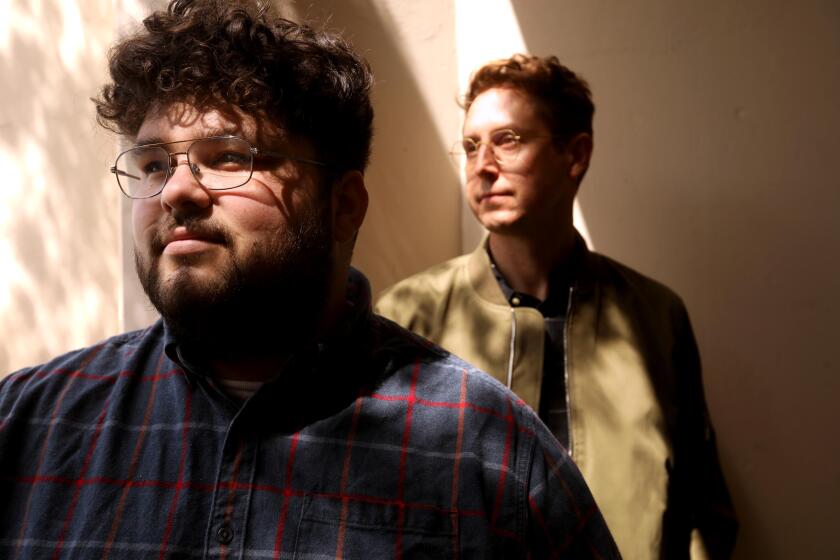Redding Wants to Become a Destination for Ecotourists
Visitors to the city’s new Turtle Bay Museum blink as they leave the summer’s hot glare and enter a cool limestone cave that mimics popular nearby Lake Shasta Caverns right down to the fake bats and cave crickets.
They emerge face-to-face with a 22,000-gallon open-air aquarium teeming with steelhead and sturgeon, giving the illusion that they have waded head-deep into the Sacramento River 100 feet away.
The subliminal shift is crafted to draw visitors’ attention to some of Redding’s top tourist attractions in hopes they’ll stay for a longer visit.
Like many Western cities built on industries such as mining and logging that are now tapped out, Redding is trying to change its economy. The Redding area lost 1,000 jobs in the early 1990s, and more than 400 last summer when the Shasta Paper Co. mill closed.
The museum complex is the centerpiece of Redding’s latest and most ambitious effort to become a destination for motorists heading through the northernmost end of the hot, dry Sacramento Valley on Interstate 5.
“We were an extraction-based culture and an extraction-based economy,” said Judy Lalouche, Redding museum president and chief executive.
“Those days are over. So how do we use these resources in a more sustainable manner and also support an economy?”
Backers want to market the city of 82,000 not just as another tourist stop, but as an ecotourist destination, catching the latest green wave.
They also hope to appeal to residents and prospective residents, many from more urban areas, who want cultural amenities like museums nearby.
“A lot of people, when they think of Redding, they think of heat, they think of stopping for gas, they think of all the wonderful scenic opportunities around us. But they don’t think of Redding itself,” said Shannon Phillips of the nonprofit McConnell Foundation.
The foundation has contributed $26 million so far to the museum and other eye-catchers in an $82-million, 300-acre riverfront park. In two years, those will include a neighboring $7.3-million, 200-acre arboretum and a dramatic $19-million harp-shaped Sundial Bridge, designed by Spanish architect Santiago Calatrava, to glow at night through translucent panels.
The museum is structured to draw visitors’ attention to the Sacramento River paralleled by a newly designated National Recreation Trail network so extensive and ambitious that American Trails moved its national headquarters here.
The riverside trails echo horse and mountain bike trails in the surrounding mountains with which they will someday connect, trails that are themselves a new use for abandoned logging roads and mining ditches.
The museum and even its furniture are conspicuously built of environment-friendly material. Visitors are greeted at the door with recycling bins advising them that “garbage is a choice.”
Its displays--from an Ansel Adams photography retrospective to a socially conscious look at mistreatment of the native Wintu Indian tribe--are centered on the tug-of-war between development and environment.
Promoting Redding as an ecotourist stop is not without its detractors in a city built on the earth’s dwindling bounty.
Museum proponents were derided as “a bunch of greenies,” Lalouche said. “A lot of the time people think [sustainability] is no-growth, it’s antidevelopment.... We’re not saying don’t use the resources; we’re saying understand the resources and make wise choices about using them.”
The Redding-based McConnell Foundation’s extensive involvement also drew objections from residents who worried that the community’s future was being planned--and paid for--by the nonprofit group.
The Sundial Bridge became a lightning rod for residents who consider it a too-radical departure from the city’s past.
Jim Zauher, president of the Economic Development Corp. of Shasta County, is among those concerned about tying the city too closely to ecotourism.
He points as well to the city’s 700-acre industrial park and pending $16-million sports complex, $5-million aquatic center, public library and renovated theater.
Similar construction across the nation aimed at supporting recreation and culture is so extensive that the National League of Cities equates it to “previous periods of great city-building in the late 19th and early 20th centuries,” when roads, sewers, telephones and electricity were installed.
Redding’s effort, Zauher said, “sends a message to a company that this is a very vibrant community; it’s not just another rural outpost.”
That’s important when “we’ve just constantly been trying to pick up the pieces of the timber industry,” Zauher said. “It’s an uphill battle.”
There are signs that it is working.
Redding has seen a 50% increase in its hotel and motel traffic in the last five years, and a surge after the Sept. 11 terrorist attacks as people look for drivable destinations, said Joseph Kerr, manager of the Redding Convention Center and Visitors Bureau.
He hopes to use the distinctive Sundial Bridge, once it is completed in 2004, as a readily recognizable symbol of Redding in much the same way that the Golden Gate Bridge is identified with San Francisco.
More to Read
Start your day right
Sign up for Essential California for news, features and recommendations from the L.A. Times and beyond in your inbox six days a week.
You may occasionally receive promotional content from the Los Angeles Times.






